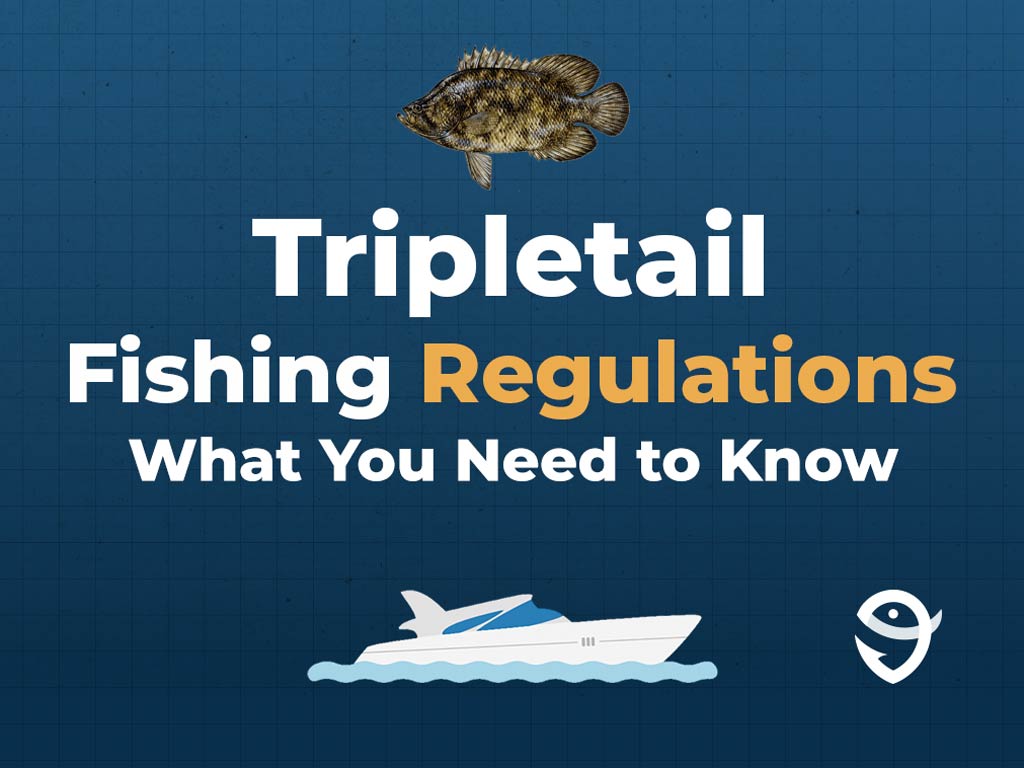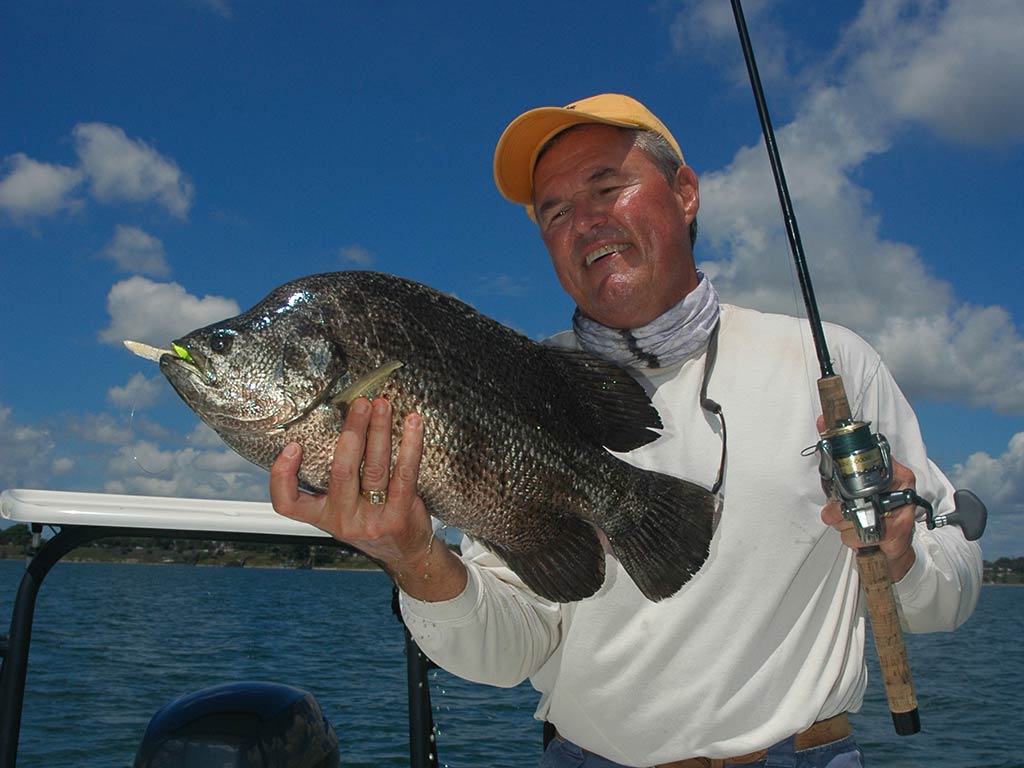Tripletail could be called the world’s ugliest game fish. If you think that’s a bit harsh, you must agree that they’re at least a strange-looking fish! Tripletail remind me of the prehistoric Coelacanth in a way. They have similar coloration and distinct fins. They’re also both passive drift feeders in the world’s oceans…

For over 50 years, I’ve fished for Tripletail in Florida – mainly as part of a fishing day for multiple species. However, some anglers target them exclusively in Florida, especially in locations such Cape Canaveral, Tampa Bay, and the entire Indian River Lagoon. These places are among the best Tripletail inshore waters, but you can also find fish offshore around sargassum weed lines. The offshore fish tend to be smaller than those found in coastal bays though.
As you can already see, there are plenty of quirks when it comes to this not-so-pretty fish. And that’s why I’m here today. I’ll let you in on everything you need to know to get your hands on one. Let’s get started.
Top Tripletail Fishing Techniques
The visual hunting aspect of Tripletail fishing is what makes the pursuit so exciting. You’ll want to try and spot the fish before casting. “Running the markers” is increasingly popular, where you cover lots of territory in a boat at planing speed while checking channel or navigational markers for the fish at or near the surface.

While Tripletail can be mahogany brown, bronze, mottled tan-and-brown, and even golden yellow in the case of the smallest fish, they’re easy to spot near the surface in sunshine.
Tripletail have the peculiar habit of floating in ambush mode, often within 10 feet of the foam trap float. When the tidal flow is strongest, they can be just inches away, ready to pick off small prey nearby. In my experience, trap floats and lines that are wrapped in floating seaweed or uprooted seagrass appeal even more to the fish. I’ve watched Tripletail pick creatures right out of the weeds before making my cast!
Run ‘n’ Gun
The drill with this method is to run a line of crab trap floats at a distance that allows you to spot the fish but not alarm them needlessly. When you spot a fish, just come off plane and circle back to the float at idle speed. Make sure you’re downcurrent of the float and fish so that you don’t drift into the fish too quickly. If the wind is stronger than the tidal current, approach from downwind.
Get into casting position at a distance that allows you to cast accurately. Have your 10–12 lb class rods rigged and ready to cast, with a variety of baits or lures – or flies
Tripletail Baits, Lures, and Flies

Top offerings for crab-trap Tripletail include live shrimp or quarter-sized blue crabs, shrimp-tipped ¼–⅜ bucktails or plastic-tail jigs, plastic shrimp, and flies that imitate bait fish, shrimp, or crabs. Favorites include the Sea-Ducer, EP Mullet, and the Del Brown Crab Fly.
These fly patterns should be cast with a floating line on a 9 wt rod, tied to a tapered leader 7–9 feet long and a 20 lb test tippet. A lighter test tippet can wear through quickly if the fish drags it against the trap lines.
If spinfishing, add a 2–3′ piece of 20 lb fluorocarbon or monofilament. You can even opt for a heavier test leader because these fish aren’t particularly leader-shy.
Make Them Eat
Whatever tackle you choose to use, the key is to retrieve the bait or lure toward the fish, which will expect its prey to come to it on the current. I’ve found that Tripletail glued to a marker post of a crab trap float don’t see a prey item that passes too far from them. They seem to have a narrow window of vision at these times.
Determine the direction the fish is facing and cast accordingly. Once the fish takes notice, keep retrieving your offering without changing the speed. The Tripletail may strike immediately but, if it’s not committed, it may track the offering back toward your boat in pursuit. In this case, stop your retrieve to let it sink. Sometimes this triggers a strike after the fish follows it down in the water column.
Keep a tight line to feel the bite. The worst thing to do is allow the fish to follow the offering right to the boat. You risk the chance of it seeing the boat and spooking. If that happens the Tripletail will swim deeper but back to the float. Wait at least 5 minutes to see if it reappears at the float and then try another cast, possibly with a different lure or fly. A live shrimp or blue crab will normally be eaten on the first presentation.
Once you hook up, try to keep the fish from wrapping your line in the crab trap line below the float. Also, use the boat motor to back up and help pull the fish away from the trap line.
Best Tripletail Sightfishing Locations

While you may not see big numbers near the surface in the Indian River Lagoon between Stuart and Sebastian, you’ll have good chances if you fish at depths of 6–8 feet. Fish near any markers you come across, casting a variety of options. Try live shrimp weighted with a couple of split shots, live shrimp rigged on a ¼ or ⅜ oz bare jighead, or a live quarter-sized crab.
The key is to let the shrimp or jig rig free-fall with the reel engaged. If a fish doesn’t make a grab on the fall, you can jig it back to the surface slowly. Make a few casts before moving to the next marker. Be sure to make a few casts away from the marker, too, not just right against it. Sometimes a Tripletail will range out from the marker in search of food.
Another productive option is searching the long lines of crab trap floats during the Florida Stone Crab season (October 15–May 1). In fact, running the trap floats is done all along the Florida Gulf coast from north of Tampa as far south as the Florida Keys, in the entire Indian River Lagoon, and the nearshore waters north of Cape Canaveral.
Other Productive Tripletail Structure
The highway bridges spanning the IRL also attract Tripletail. Cast very close to bridge abutments with your lure or bait, from the surface all the way to the bottom. Tripletail can reach impressive proportions here, with 5–10-pounders common, and even some specimens weighing 15–20 pounds.

Be sure to use spinning or casting tackle in the 10–12 lb class or, if fly fishing, a 9 wt rod at the minimum. A bite leader or fly tippet of 20–25 lb test will stand up to the Tripletail’s small, raspy teeth and also decreases abrasion from Jack Crevalles or Ladyfish that also hang around bridges and channel markers.
Waters lacking navigational post markers and crab trap floats can still offer the chance to spot Tripletail at the surface. I’ve learned from experience that standing up while running your boat allows you to spot free-floating Tripletail that you’ll miss if sitting down.
I always stand while running my boat for safety reasons and to spot manatees. If you come across a Tripletail and frighten it with the motor, it will dive out of sight. Don’t consider that a lost chance! Keep your eyes on the spot where it was, circle back, and shut down your motor. Give that fish a chance to rise back to the surface. If it reappears, idle your boat into casting position.
Should the surface waters have rafts of either floating sargassum or turtlegrass, all the better. The chances of seeing Tripletail increase because the grass provides surface refuge for bait fish, shrimp, and crabs. Idle along slowly and stand as high in your boat as possible to spot Tripletail floating among the vegetation. If the floating grass is very thick, you might have difficulty retrieving your offerings without snagging. Consider lures that are rigged weedless and flies that have added monofilament weedguards.
Tripletail Fishing Safety Considerations
Other than the long anal and dorsal fins that make this fish appear to have three tails, you’ll notice formidable fin spines. The Tripletail should never be landed by hand. Always net this fish – even smaller specimens you intend to release. The spines of the forward dorsal and anal fin are spear-sharp and strong. They inflict nasty punctures on careless anglers.
You also don’t want to lift this fish by the gill plate from the water, boat floor, or net either. The plate has a sharp, serrated edge that can cause lacerations. Lastly, the jaw is not a handle! This is due to the fish’s two sets of teeth – a row of outer canines and an inner band of small teeth. Both can cut your fingers.
Tripletail Fishing Regulations

Before heading out to put this delicious fish, you just need to know the laws. All south Atlantic and Gulf coastal states regulate the recreational and commercial take of Tripletail.
Florida regulations call for a minimum size limit of 18 inches and daily bag limit of two fish per person. State regulations apply in federal waters off Florida as well, and there’s no closed season. Permissible gear includes rod and reel only – no nets or spearing are allowed. Multiple hooks are allowed on artificial lures, but cannot be used in conjunction with live or dead natural bait.
Most states adhere to a minimum length of 18 inches, however, they differ when it comes to the bag restrictions. Georgia allows two fish per person, South Carolina: three (and nine fish per bat), while Alabama has no bag limit. You can take three Tripletail per day from Mississippi’s waters and five in Louisiana.
The exception is Texas, which has a 17-inch minimum limit. You can also keep up to three fish.
Tripletail Fishing: A Well-Kept Secret

It’s not common knowledge that Tripletail possess the qualities of more high-profile game fish. They have a wide range in tropical and sub-tropical waters, they present a casting challenge, put up a great fight, and even jump at times. Tripletail readily strike natural baits, lures, and flies, so anglers of all persuasions and skill levels can hunt and capture ’em. Hopefully, you now see why you should get in on the fun and land yourself a tasty treat to take home!
Have you ever caught a Tripletail? What tactic did you employ to land it? We’d love to hear from you in the comments below!
The post How to Go Tripletail Fishing: An Angler’s Guide appeared first on FishingBooker Blog.
https://ift.tt/1pmhvHT
0 Comments
Enregistrer un commentaire